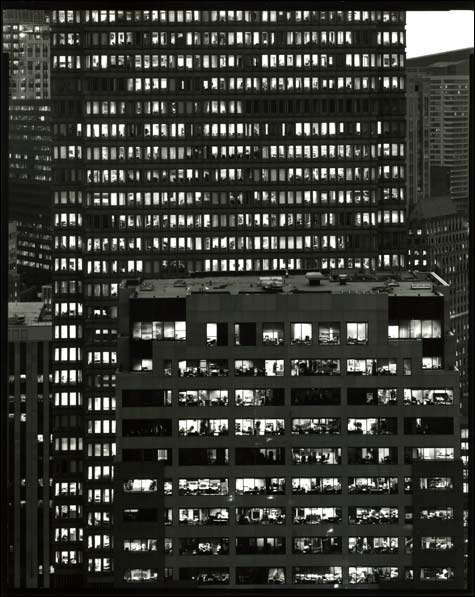
VIEW OF STATE STREET BANK, BOSTON (2002) Nixon's photos from the past decade are about precise placement, like a game of Tetris. |
Photographer Nicholas Nixon of Brookline first burst onto the scene in the show "New Topographics." The 1975 exhibit at the George Eastman House in Rochester, New York, became known as a benchmark for the way it rounded up 10 artists to map a trend in landscape photography toward dispassionate, detached, understated, decidedly unromantic observation. Nixon's contribution included black-and-white photos of Boston cityscapes that he began taking from downtown rooftops after he moved here in 1974.
"NICHOLAS NIXON: 8X10 AND 11X14" | Carroll And Sons, 450 Harrison Ave, Boston | Through May 9 "JOE JOHNSON: MEGA CHURCHES" |
Gallery Kayafas, 450 Harrison Ave | Through May 12 |
"I just sort of dealt with Boston like it was mountains and hillsides," Nixon tells me over the phone. They tend to be open uninflected vistas, showing the expanse of the city with skyscrapers jutting up here and there.
"Nicholas Nixon: 8x10 and 11x14," a then-and-now show at Carroll and Sons gallery, assembles a selection of this work alongside Boston cityscapes that Nixon has shot over the past decade. It's a welcome opportunity to catch up with the man who may be the city's most nationally renowned artist.
Boston, as far as America is concerned, is a photography town. About a hundred years ago, America was impressed by our painters, "American Impressionists" like Frank Benson of Salem, and Edmund Tarbell of Dorchester, and Dorchester native Childe Hassam. Today we have burgeoning clusters of tech and conceptual/installation/performance artists. But since World War II, whenever the art made by Bostonians has caught the fancy of the rest of the country, it has most often been our photography (think Harold "Doc" Edgerton, Nan Goldin, the Starn Twins).
These days, Boston photographers get the big shows. Abelardo Morell at the Art Institute of Chicago in 2005 (and at Framingham's Danforth Museum through May 14). Laura McPhee at Boston's Museum of Fine Arts in 2006. Frank Gohlke at Texas's Amon Carter in 2007 (the show traveled to the Addison Gallery last spring). Maria Magdalena Campos-Pons (photography is just part of her output) at the Indianapolis Museum of Art in 2007. And Nixon at Washington's National Gallery of Art in 2005 and New York's Museum of Modern Art in 2007.
Nixon may be best known for his photos of elderly people in nursing homes, people dying of AIDS, and, annually since 1975, the Brown sisters (his wife and her four siblings). At Yossi Milo Gallery in New York last year, he exhibited photos he's shot over the past few years of patients — in particular terminally ill people — at Boston Medical Center and the Dana Farber Cancer Institute. As I look back over the 61-year-old's career, it seems he's become a social documentarian, with a focus on dying. The "Brown Sisters" series is about the march of time. At this point you can't help thinking about how it will end. Nixon says his recent cityscapes have served as a break from all this emotionally intense stuff.